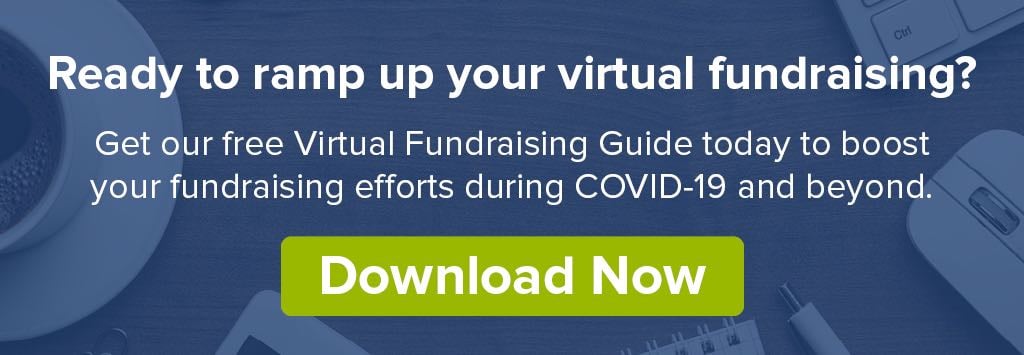
The cost of acquiring a new donor is increasing, and the average donor retention rate for first-year donors is between 22% and 29%. Eek! The bottom line is, it's much cheaper to keep your current donors than it is to acquire new ones.
Improving your donor relations (also called donor care or donor stewardship) is one of the most effective ways to increase your donor retention. But it does take some strategic work. If you increase your donor retention rate by just 10%, that can increase the lifetime value of your donor database by 200%!
Now that's a nice return on your investment.
Donor care is both an art and a science. There are some industry "best practices" that every nonprofit should do, but there’s also a whole lot of room to be creative. We're here to help you put the essentials of excellent donor stewardship into practice so you can build great relationships with your supporters and improve your fundraising.
Donor Relations Is The Nonprofit's Customer Service
Donor relations is the equivalent of customer service. It's critical to make every donor feel special and important, just like excellent customer service makes you feel valued. That means donor care can't become an afterthought! Effective donor relations can turn first-time donors into long-time, loyal supporters.
Aside from improving donor retention, good donor care increases your supporter's loyalty and enthusiasm for your organization, which often leads to more substantial gifts and better networking opportunities.
When done well, excellent donor care reveals a lot of valuable information about your donors that can help you provide even better service. Wouldn't you love to know how each donor makes decisions about their charitable giving? It would be great to understand how every single donor appreciates hearing from your team and what information they need before they're ready to make a gift. Good donor care can provide all this information (and so much more) to your fundraising or development team.
Donor Relations Must-Haves
Here is a list of what we believe are the donor relations "must-haves." Think of these as non-negotiables, industry-standards.
Understand your donor data (and use it).
Every nonprofit should collect data and information about each and every donor. The right donor data will help you understand who your supporters are, what programs they are most likely to support, and the best method to ask them to give.
Your organization should collect four kinds of data:
- Basic information: Hopefully, you're gathering their name, age, where they live, profession, marital and family status. You should also learn about other organizations they support and what excites them about your nonprofit specifically.
- Communication preferences: You should ask each donor about their preferred forms of communication, how often they would like to hear from you, and what content they consider most valuable.
- Giving preferences: This might be less important for donors enrolled in giving programs, but it's helpful to know how often they prefer to make charitable donations and the donation amount or range they're most comfortable with. This will also give you a sense of their capacity to give.
- Why they support your organization: You need to understand why each donor gives to your organization so you can deliver on their expectations.
Imagine creating email lists where you know every single person on the list wants to receive that update! Think of how valuable it will be to understand how often a major donor expects to hear from you, instead of just guessing. That might seem like an overwhelming amount of information to collect from hundreds or thousands of supporters. Once you have a system in place to gather that data (and a CRM system to help you stay organized), you'll be well on your way to offering five-star donor care.
Once you have all that information, you need to use it! This kind of data can help you communicate more effectively with your supporters, which leads to better fundraising results and higher donor retention rates.
If you don't have this kind of information, take the opportunity to call your donors and ask. Allow them to share how they would like to see you improve your donor care. While you're on the phone, tell your donors about the impact of their previous gift and what your organization is accomplishing. Ask about the possibility of increasing their involvement or giving to your organization.
Ask, thank, report back, repeat.
At the heart of excellent donor care is this pattern of asking for a donation, offering heartfelt gratitude, reporting back what their gift accomplished, and repeating the cycle. Think of it as creating a donor journey.
This is where your organization can be creative and let your personality shine. There's a lot of freedom to come up with your own ways to ask, thank, and report back to donors.
Create beautiful donor welcome packs and send personalized, hand-written thank you notes. Write story-focused newsletters with donor profiles. Come up with ways your supporters can engage with your nonprofit that doesn't involve money. The options are only limited by your creativity (and what your team can reasonably pull off).
Do you have this "donor journey" written down? If it's not written down, it probably won't happen. Take the time to list each action your team will take within each "step" of the cycle.
For example, name all the ways your organization will thank each donor throughout the year and a list of all the "asks" you will make each year? Writing all this down or creating a chart will dramatically improve your donor care processes and ensure everything actually gets done.
Think of it as creating a monthly, quarterly, and annual to-do list for donor care. It will probably require some extra work up front, and it will evolve over time, but this process will benefit everyone--including your donors.
Make it easy for your donors to give in a variety of ways.
Look for every opportunity to make it easy for donors to give and leverage the impact of their gift. Do you have a list of all the different ways people can make a donation? Remember, many major donors think long term. Educate your donors on how they can give stocks and bonds, add your organization to their will or trust, and other long-term giving options. Include information about your monthly giving programs. Remember, donor care is about cultivating life-long relationships.
On a practical level, make sure the "donate" buttons on your website are easy to find and work properly. Create a custom donation page that is easy to use and includes essential information about your organization.
Provide a matching gift database like Double the Donation so donors can take advantage of any matching gift program their employer might offer. Matching gift databases make it easier for people to fill out the paperwork and help you get more money!
Show PDG (Public Displays of Gratitude).
We've all heard of PDA (public displays of affection). Nonprofit organizations should show public displays of gratitude (PDG) as frequently as possible. Nothing motivates a donor to stay engaged like a hearty "Thank you" and a little PDG. Everyone wants to feel appreciated for their generosity.
There are endless ways to show public displays of gratitude.
- Profile donors in your newsletters.
- Recognize gifts made in memory or honor of someone, so their legacy is celebrated among the whole community (with the donor's permission, of course).
- Create a new donor welcome package with a few small gifts that show appreciation and educate them about your cause.
- Host an appreciation event for your donors and volunteers (and don't ask for money… just say thank you).
- Thank your donors on social media.
- Send anniversary and birthday cards to your major donors.
- Go one step further and send cards celebrating 5, 10, 15, and 20 years of giving!
This is where your creativity can really shine. It's really an opportunity to delight your donors. You can also ask a few trusted donors how they would like to receive public displays of gratitude.
Get donors involved with what you do.
The fundraising department asks, "How do we get people to care and give to our cause?" The donor relations department asks, "How do we get people involved with where their money is going?" These are two sides to the same coin because anyone who is personally involved in the cause will be more likely to give some of their hard-earned money.
Look for opportunities to connect your donors with those who are benefiting from their generosity. Ditch the tote bags, calendars, and coffee mugs with your organization's logo. Provide personal thank-you letters from a beneficiary or opportunities to see and experience what they helped accomplish. For example, if your organization provides healthy lunches for at-risk students, invite your donors to have lunch with the children one day. Even if they can't attend, the invitation goes a long way to build trust, demonstrate transparency, and show appreciation.
As we said, these are the donor care must-haves. There are many other things you can add to your donor care plan that will help build lasting relationships with your supporters.
Donors are your nonprofit's most prized resources, and donor care is essential to the financial success and stability of your organization.
Here are three more resources to help you take your donor relations to the next level.
- 5 Surefire Ways To Improve Your Nonprofit Storytelling: When done correctly, storytelling can make your communication with donors more impactful and engaging. You can use stories to help people understand the problem and inspire them to take action. You can also use stories to report back and tell them what their donations accomplished. Here are five ways every fundraiser and development professional can improve their storytelling.
- 4 Ways Donation Transparency Increases Fundraising Success: Financial transparency is an excellent addition to any donor care strategy because your supporters expect to know how your nonprofit handles finances. Here are some practical ways to share your financial statistics with your donors in a way that actually builds trust.
- Nonprofit Payment Processing: A Complete Guide and Glossary: Every nonprofit must be able to process online donations. This resource will help you understand how nonprofit payment processing works, the different types of processors, and how recurring donations are processed online. Creating an enjoyable, seamless online giving experience is a critical piece of the donor care puzzle.
